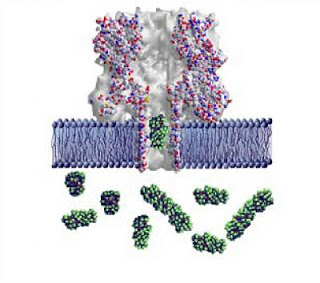Nano-Membrane Mass Spectrometry?
 Biological materials are capable of performing many tricks that nanotechnologists have yet to master. Brazilian and American scientists have collaborated in research that shows that lipid bi-layers are capable of serving as nano-scale mass detectors.
Biological materials are capable of performing many tricks that nanotechnologists have yet to master. Brazilian and American scientists have collaborated in research that shows that lipid bi-layers are capable of serving as nano-scale mass detectors.In a paper appearing next week in the Proceedings of the National Academy of Sciences,* the team proves for the first time that a single nanometer-scale pore in a thin membrane can be used to accurately detect and sort different-sized polymer chains (a model for biomolecules) that pass through or block the channel.Source
Traditionally, unknown molecules are measured and identified using mass spectrometry, a process that involves ionizing and disintegrating large numbers of a target molecule, then analyzing the masses of the resulting molecules to produce a "molecular fingerprint" for the original sample. This equipment can cover a good-sized desk. By contrast, the "single-molecule mass spectrometry" system described in the PNAS paper is a non-destructive technique that in principle can measure one molecule at a time in a space small enough to fit on a single microchip device.
The technique involves creating a lipid bilayer membrane similar to those in living cells, and "drilling" a pore in it with a protein (alpha-hemolysin) produced by the Staphyloccoccus aureus bacteria specifically to penetrate cell membranes. Charged molecules (such as single-stranded DNA) are forced one-at-a-time into the nanopore, which is only 1.5 nanometers (the diameter of a human hair is about 10,000 nanometers) at its smallest point, by an applied electric current. As the molecules pass through the channel, the current flow is reduced in proportion to the size of each individual chain, allowing its mass to be easily derived.
In this experiment, various-sized chains in solution of the uncharged polymer polyethylene glycol (PEG) were substituted for biomolecules. Each type of PEG molecule reduced the nanopore's electrical conductance differently as it moved through, allowing the researchers to distinguish one size of PEG chain from another.
As a control, a solution of a highly purified PEG of a specific size was characterized with the nanopore. The resulting "fingerprint" closely matched the one identifying samples of the same size polymer in the mixed chain solution.
Further enhancement of the data from both the experimental and control tests yielded mass measurements and identifications of the different PEG chains that correlate with those made by traditional mass spectrometry.
Nanotechnologists have yet to solve many problems relating to molecular assembly. One of the problems is how to collect information about molecules, on a nano-scale. Identifying molecules by size and function is absolutely necessary for molecular assembly.
Molecular machines must have their own ways of processing information and performing energetic actions appropriate to their location within the larger assembly process. By mimicking biology, and utilising biological materials in creative ways, nanotechnologist will begin to bridge the huge gap that currently exists between biological molecular assembly, and the dreams of diamondoid assembly and other molecular assembly processes and systems.
Labels: Nanotechnology
0 Comments:
Post a Comment
“During times of universal deceit, telling the truth becomes a revolutionary act” _George Orwell
<< Home